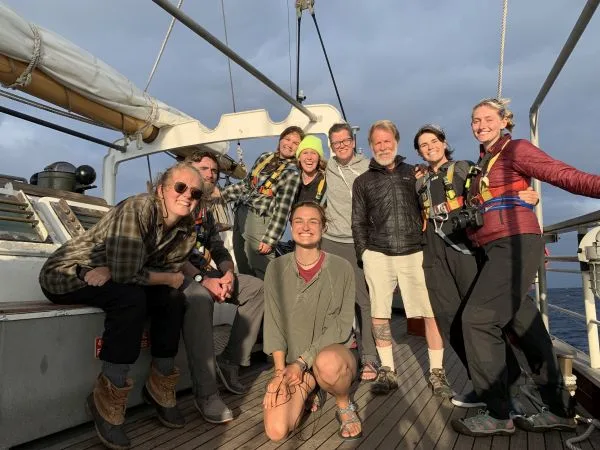News
Sun at Last!

Author: Kelsey Lane, Chief Scientist
Ship’s Log
Position
34* 58.0’N x 146*19.9’W
Heading
315
Speed
5 kts
Sail Plan
4 lowers
Weather
Air Temperature 23*C, Sea Surface Temperature 23*C and Cloud Cover 3/8 – Woo Hoo!
Wind
Winds out of the east, F4
Description of location
Nearing the geographic middle of the North Pacific Subtropical Gyre
Yesterday evening, the clouds parted and we had our first sunset appreciation club. We (a lot of the ship’s company, on and off watch) all gathered on the quarterdeck, enjoying the lull of the ship and the glowing sky, turning from blue to pink to red. I’ve seen many sunsets at sea, but after the last couple weeks of cloud cover, this sunset was special. As we gathered, a guitar came out and I brought up my fiddle. Kyla started singing for us and I joined in with some fiddle accompaniment. She even shared a beautiful, original song and it was so fun to learn some new music. The beautiful notes drifting over the wind carried to everyone on deck.
This morning, we had an exciting morning science station chock full with a hydrocast, a neuston net and some water sampling. I dip netted as well, reaching a long-handled net over the side of the ship, picking up any plastics that drifted by as we sailed slowly for the neuston net tow. Sarah, Noah and Payton helped me, standing forward of me and calling out when plastic was coming. “There it is! White! Get ready!!” Sarah aptly described it as a video game to spot and catch them quickly. I caught 5 pieces of plastic, of small to medium size, but all covered in some sea life. We find lots of crabs living on these plastics, plenty of gooseneck barnacles and even the occasional frog fish. Most of the plastic is too degraded and broken down for us to distinguish its’ original purpose, but sometimes we find something strikingly familiar, like a blue laundry detergent bottle covered with bryozoans, hydroids, algae and home to a few crabs. I wondered how long it had been here, drifting and circulating in the gyre.
After station, we struck the storm trys’l and set the full mains’l again, as the winds have settled down to a nice 15 knots or so. After lunch, I worked with the Assistant Scientists Supi and Emily to troubleshoot an equipment issue and we had a lab practical and the students showed us their prowess and skills in lab and science deployments. I spent the rest of the afternoon with the plastics group (Becca, Christina and Sophia) helping to process our haul.
They’ve been hunting for large plastics to explore what colonizes these artificial substrates and we found none at all in the earlier parts of our cruise track in the California Current. I was getting worried we wouldn’t have enough data for them, but now that we’re in the gyre, there’s plastic everywhere! They’re busy every day! The densities are high. We knew they would be, but seeing it in real life can still be a shock. During our hourly six minute observations of the ocean, we see more plastic (>50 in six minutes!) than we see any wildlife like seabirds, flying fish or marine mammal. We’ve also been seeing ghost nets and large enough debris we have to maneuver the ship to avoid it. It’s not an island of plastic out here, but the amount is still overwhelming.
We finished our work by the time the dinner bell rang and we went down to the main saloon to eat delicious bao prepared by Lauren (Cookie) and Sam (Assistant Steward) with an amazing kale salad. I can’t believe they made bao for 35 on a moving ship, three weeks from port! We are so lucky with the food here, thanks Cookie! After dinner, the sunset appreciation club got to gather for our second meeting of the trip. There was more music, chatting and enjoying the spectacular, ever evolving hues of the sunset.
This trip has really been my experiences with SEA coming full circle. I was a student on this ship ten years ago. After I graduated from college, I went to work on boats and sailed with SEA as an Assistant Scientist for five years. That career led me to graduate school for oceanography, inspired by my student trip and the subsequent years spent at sea studying and teaching about the ocean. I feel so honored to be back on this ship, working with the next generation of SEA students. I hope they remember these long, hard, but oh so memorable days far offshore beyond most people’s perception of where the ocean horizon ends. Life at sea and these moments are so hard to describe, but so fulfilling, and wherever life may take them, I hope these days will inspire them as they inspired me.
Take care out there!
– Kelsey Lane, Chief Scientist
Shoutout to my twin sister, Ingrid, as we celebrate our birthday tomorrow! Love you! Also sending love to Ryan, Becky, Kelly and family and friends.
Contact: Douglas Karlson, Director of Communications, 508-444-1918 | dkarlson@sea.edu